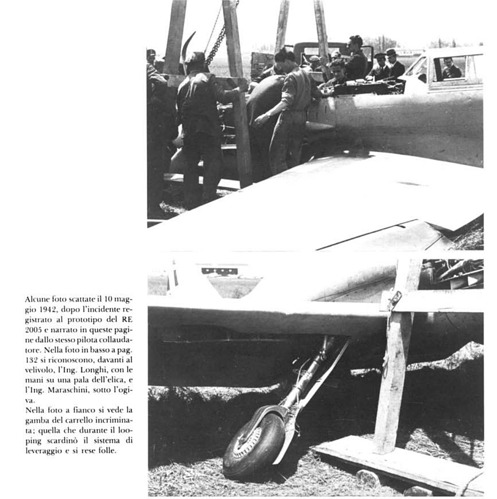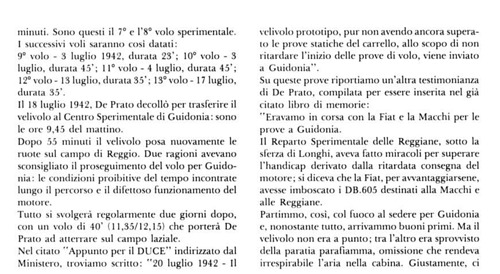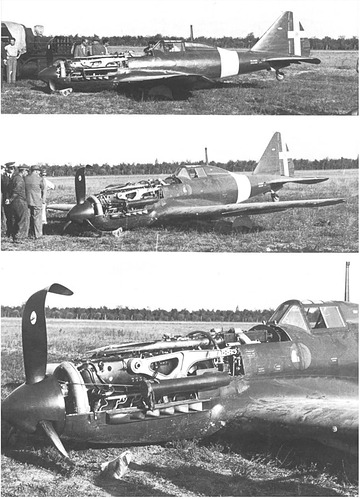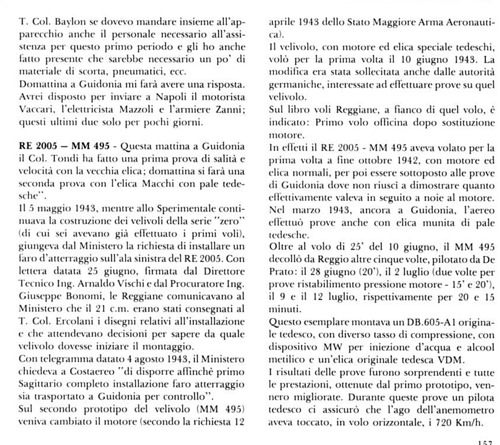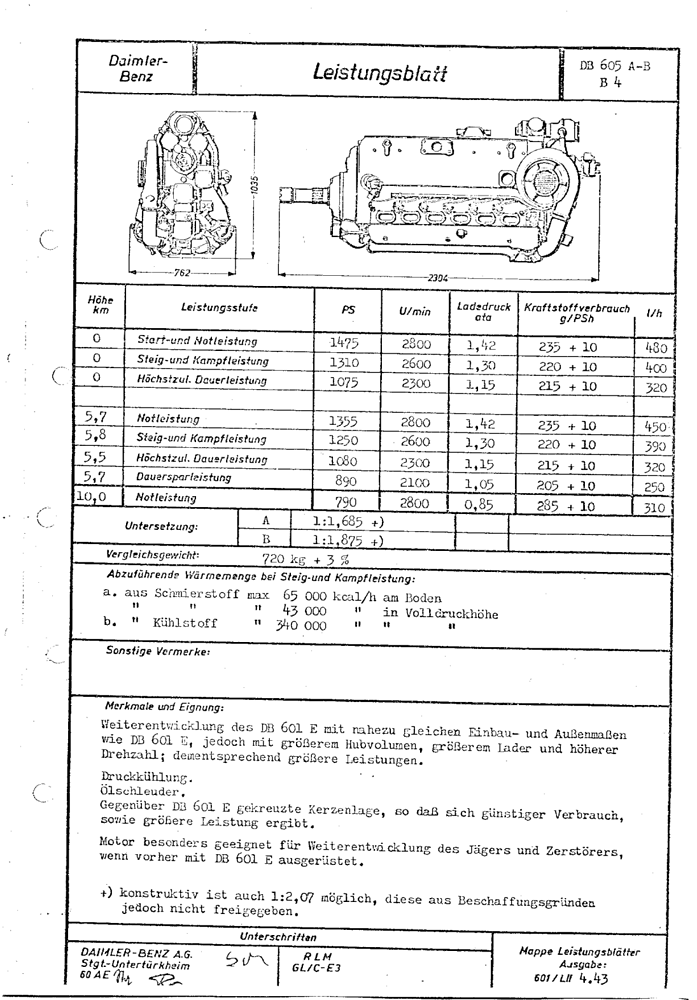Remember that the pic you used is using data feom early MM494 which had an engine in bad shape and couldn’t use WEP. Probably even when at 100% it wouldn’t develop all the hp it should have so the serie 0 should definitely perform better than this.
It depends if they give VDM the same efficiency as the Piaggio propeller. In theory the VDM should be more efficient so we’re not just talking about a raw 300hp, even though that should be the bare minimum.
I tested the plane with and without WEP and at the 2600rpm limitation. In WEP, it is faster than what the document claims by 11 kph and without WEP it is slower by 20 kph.
Historically speaking, the DB 605 was a fairly problematic engine that had a whole lot of teething issues that were not just limited to the Italian version. It appears that the Bf.109G with the DB 605 w/ larger DB603 supercharger was not even test flown until late summer of 1943.
The only way to make the 720kph number even plausible is if you assume that the Germans prioritized development of the Italian airframes, provided them with an engine that their own domestic aircraft manufactures would not have access to until a good bit later, and that the Italians had also developed an airframe with extremely low drag ratios relative to it’s size; i.e the Re.2005 has a wing with laminar flow design and the production capability and design considerations to have the same return of investment as the P-51. And that they were capable of equaling late model P-51 Mustangs around a year before it went into service…all the while utilizing inferior fuels.
And it is important to keep in mind that the only thing that supports this claim is that a test pilot allegedly said that the plane reached 720km indicated airspeed at 7300m. The indicated airspeed is an important note because 720km at 7300m is going to be equal to over 1000km of true airspeed; which would make the Re.2005 the fastest propeller driven airplane in the world by an extremely wide margin.
So what is more likely? Italy developed the worlds fastest propeller driven fighter in 1943 and Germany decided to never to produce it. Or that something was lost in translation somewhere along the lines and secondary source authors never bothered to evaluate the 720 km/h claim?
As others have already pointed out in the past few days, this topic was not created to have a discussion on feasibility and go offtopic, but to collect the various data of the aircraft in question so that the developers can make a correction. It would be more correct to move the discussion on who is right and who is not to another topic, so as not to clog up this one and risk ending up in offtopic.
the challenge of who has the longest in historical matters, although interesting at least in my humble opinion, is not part of the current discussion
The MM.495 just got a DB605AM, not the one with the bigger compressor. We are quite sure about it.
I wrote the 720km/h performance as that’s the only number we have rn. I don’t want the plane to go that fast if it couldn’t irl and I’m not gonna die on this hill.
My comment was purely on the Re2005 serie 0 performance vs that of MM494: I don’t want to increase confusion on the various prototypes performance. The last thing we need is to give gaijin excuses to nerf even the serie 0 to MM494 levels.
As I think I stated in some comments and in the post, rn the priority is to give the plane the DB605AM and its extra 300hp. After that I’d like to see it get better prop efficiency. For top speed and climb rate idk if we’ll ever get any data so any calculation is welcome.
Really interesting work on the numbers and test results so far — nice job! Just one small note though: I’m not sure if you guys ran the tests the same way they were actually done back in the day. The method used at the time was pretty specific, and all the major air forces followed roughly the same procedure — Luftwaffe, Regia Aeronautica, RAF, USAAF, you name it.
They didn’t just climb up to 7 or 8 km and see what speed they got in level flight. The usual process was to climb above the target altitude, usually by about 500 to 1000 meters, then make a shallow dive down to the exact test height — say around 7,000 meters — and let the plane build up to top speed naturally. Trying to accelerate to max speed in level flight at those altitudes was almost impossible, so the dive was standard practice.
Once they hit the test altitude, the pilot had to hold the plane steady and fly straight and level at full power. Then came the actual measurements: several passes along a fixed course, always in both directions to cancel out wind effects. People on the ground — using theodolites, cameras, or timing gear — would measure the time between markers, and from that they’d calculate the average true airspeed. The final speed figure wasn’t just what the cockpit gauge said — it was corrected for air density, temperature, and pressure.
So if you want to do it properly in the sim, try to follow the same steps. Don’t just climb and read the speed indicator. Go a bit higher, dive gently to your test altitude, stabilize, and make a few straight passes in both directions over the same line. Average the results, and you’ll get something much closer to how the real tests were done back in the day.
I know it’s not exactly the same thing, but I actually used the same way years ago trying to hit the mythical Mach 2.2 in the F-104S in level flight — and it worked!
“for now let’s focus on finding and making bug report on db605am because this is more than enough to make great change in flight performance extra 300hp + are big upgrade” and then we can do the vdm with better prop efficiency and so on"
lets take at what smin1080p said
I think there’s not much use speculating anything without having the proper sources. And from what I’ve read, Regianne’s archives are closed for the time being.
I did find a very in-depth book on it, interesting things to note
m.494 was cursed with several issues causing it to crash several times.
It also had a faulty engine, and according to test pilot De Prato, rumor was that FIAT sabotaged the DB 605 engines meant for Macchi and Reggiane by delaying deliveries (possibly also sabotaging the engines themselves)

First crash was in 10 May '42, on the first flight, due to a landing gear leg not deploying properly requiring a belly land which consequently a prop strike, and possibly damaged the engine further.
It also didn’t help that m.494 Piaggio propellers were also faulty and didn’t maintain constant RPM, causing instability and possibly engine damage.

July 18 '42, De Prato (test pilot) tries to ferry m.494 to Guidonia but has to abort due to engine malfunction.
July 20 '42, they ferry m.494 to Guidonia, without completing landing gear tests to avoid missing the trials, and without a seal around the engine firewall, which caused exhaust to leak into the cockpit.
On the first take-off at Guidonia, before even clearing the airfield, the engine vibration caused the DB 605 water coolant loop tubing to crack and leak boiling water on De Prato’s leg, and overheating the engine, the only one they had, causing him to crash land m.494 yet again
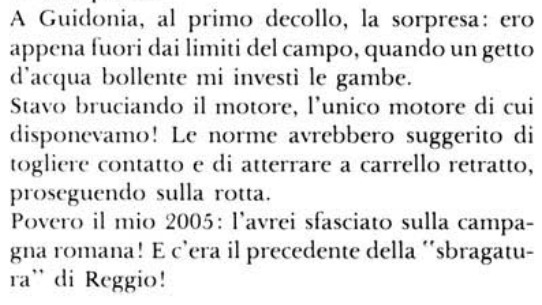
July 20, during dive tests, the landing gear fairings detached when approaching 900 kph, damaging the aircraft, resulting in m.494 being sent back to Reggiane for repair and reinforcement

Semptember 23, there was yet another crash caused by engine ceasing to function during landing approach, resulting in yet another crash landing and prop strike, during the Guidonia trials, piloted by colonel Angelo Tondi

from October onwards, m.495 is sent to Guidonia and partakes in tests with the old prop, the VDM prop, and a new engine, requested to be tested by Germany. Sadly, no performance data is included.
It does specify:
- The engine is a DB 605-A1 with MW-50 water-methanol injection
- Different compression ratio
- German VDM prop
Important to note that the exact sentence regarding the 720 kph claim in level flight is “a German pilot assured that the anemometer’s needle touched, in horizontal flight, the 720 km/h mark”
Anemometer is the airspeed indicator. It does not say if it is indicated or true. It also doesn’t state the altitude. But the common sense here is that it is TAS. But alas, it’s not performance data.
m.495 also swapped the 12.7mm wing-mounted machine guns got swapped for MG151 20mm cannons
m.495 was later taken by Germany to Reichlin Experimental Center.
in Guidonia Experimental Center, in the serie-5 trials, (does not specify if it’s m.494, 945, or any mods of both) from the evaluation commission:
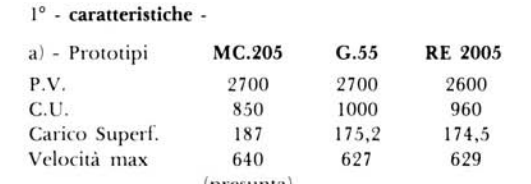
Serie 0 in game features a DB 605 A with 1310 HP at max power, and 1477 HP WEP/Takeoff, so using the Serie 0 to compare m.494 (mod 1. and mod.2) and m.495 is pointless, because Serie 0’s engine is nowhere as anemic as m.494 or 495 regardless of the VDM or not.
If the airspeed indicator needle touched the 720 km/h mark…this means that the figure is an indicated air speed.
that’s what I would say but perhaps it had different instrumentation for test flights, who knows.
The figures I am quoting in-game for 5,900m are done by diving from 7km spawn in test flight and then letting plane decelerate to a point where it is not losing speed.
We cannot duplicate the real life testing procedure to the letter because we do not have a timeframe for how long they let the plane decelerate. It would be possible to get a higher measured top speed by 5-10 kph if the instrumentation at the time and timetable did not account for the last bits of declaration; i.e deceleration from 640-630 takes a long time.
this book was among those used for the original bug report.
As I stated in the post, the DB605A-1 paired with a MW-50 is really just a DB605AM.
What is the date on the last chart though?
ok fair enough. Thank you.
You mean 1944? It’s the year in which they started mass production of fighter equipped with that engine.
The engine was in the work before that and the MM.495 received what was probably a prototype since the way it’s described seems exactly like a DB605AM
What primary source indicates that it’s a DB-605AM that was used in the Re.2005 MDM.495?
The test flight of the plane with the German built engine and prop is in June 10, 1943. This timeframe just doesn’t seem very likely when you consider that the earliest documentation of using MW-50 on a Bf.109G-4 in a test flight is from September, 1943. And according to “The Secret Horsepower Race” / Calum Douglas, the DB-605 was something of a flaming dumpster fire in basically all of the first half of 1943.
Assuming that the Re.2005 was equipped with MW-50 would require the following,
-
Major engineering problems for the DB-605 were solved by the middle of 1943. We can hand waive this as say that the engine shipped to them was basically a prototype held to the highest standards even if we have no proof.
-
The Germans prioritized the development of the Re.2005 over their own domestic designs due to the test flight occuring 3 months prior to the earliest available documentation of flight testing a Bf.109 with MW-50.
- An alternative is that the Bf.109 was tested prior to the available documentation and that none of the earlier documentation or even mention of the testing survived the war.
Either scenario is more unlikely than it is likely.
What DB605 are you talking about? The A or the AM version?
All of the serie 5 aircraft were equipped with a DB605A engines and so did some other german planes so I guess not all DB605A were flaming dumpsters. If you are talking about DB605AM then Idk.
Some books say the MM495 was give to the German and it was given a “special” DB605A. This special engine had modified compression rates and Methanol and water injection. It was never called DB605AM so we don’t have primary sources.
Why do we believe it was a prototype of a DB605AM? Because if you look at Daimler-Benz info on the engine it is literally stated that the DB605AM is a DB605A with modified compression rates and MW-50. So it makes sense that they didn’t tell the italian engineers that they gave it a DB605AM (since they wouldn’t know what it was), but instead told them the changes they made to that “special” engine.
Again, those changes match in a 1 for 1 the characteristics of the DB605AM. I don’t know why the German would test it on the Re2005 other than just test if a different fram would change the engine’s performance… or because if they broke it they wouldn’t lose an otherwise repourposable Bf109 frame.
However it seems to me pretty unlikely that the engine was something other than a prototype DB605AM because… seriously what other engine could it be?
We are trying to get the primary documentation for these changes and possibly some figures for the performance.
I am talking about the DB-605 in general.

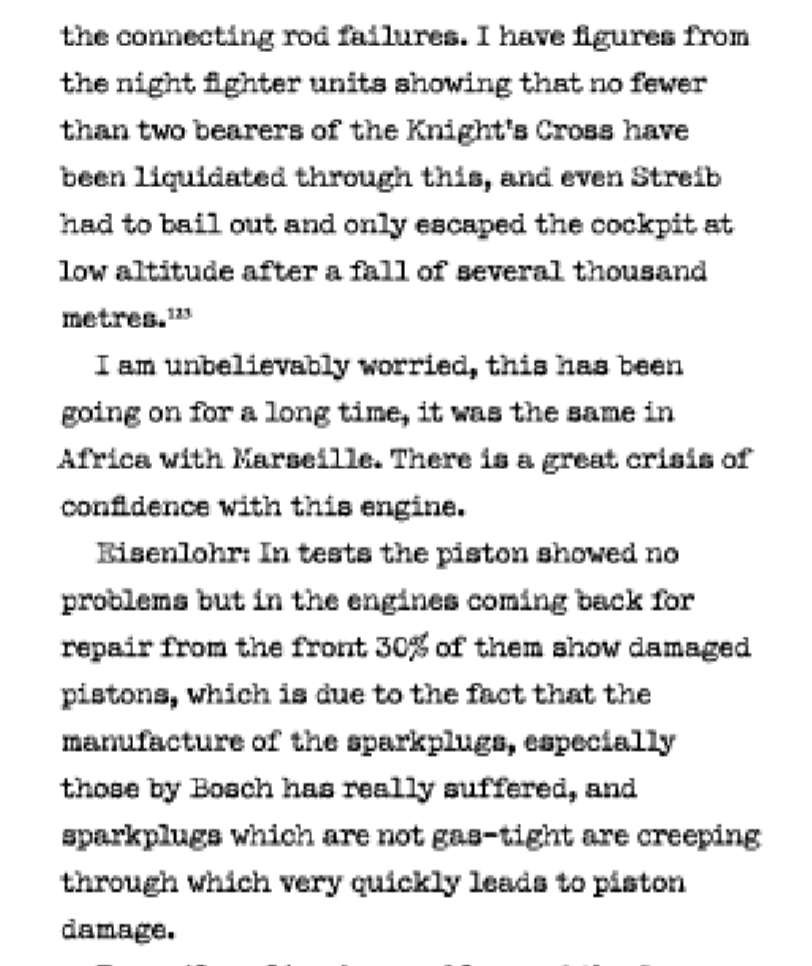
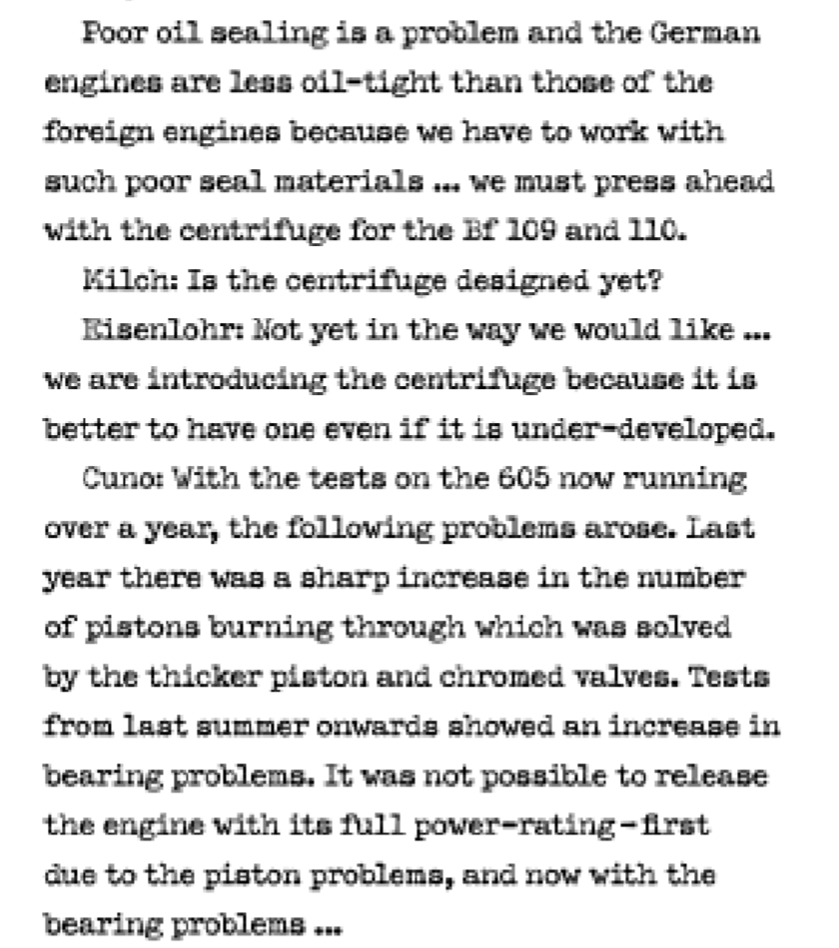
Hopefully the screenshots are in the correct order, but according to Calum Douglas translation of Luftwaffe meetings, the DB-605 was not performing well in 1943.
The engine was actually even worse in 1942. The Italians built engines were not special in the fact that they had to be de-rated.
And what primary sources do these books cite to make that claim? That is the crux of the issue. It seems that the MW-50 equipped engine claim is probably dubious given the timeframe for the test flight.
Did these authors just see that the German engine was labeled as “special” in Italian documents and just assume that meant it was equipped with MW-50?
I think it is just as likely, if not moreso, that the engine that Germans equipped it with was not equipped with MW-50, but instead incorporated the technical changes that were made in order to get the engine to run more reliably and not have to be de-rated.
It seems odds that the Germans would equip and test fly an Re.2005 with MW-50 before they even attempted to equip and test fly their own fighters with it. It’s an even more odd conclusion when you consider that the June 10th test flight date would mean that the Germans equipped the Re.2005 with MW-50 prior to concluding their own research into it.
As I’ve mentioned above…it is incredibly unlikely that the engine was a DB-605 AM.
